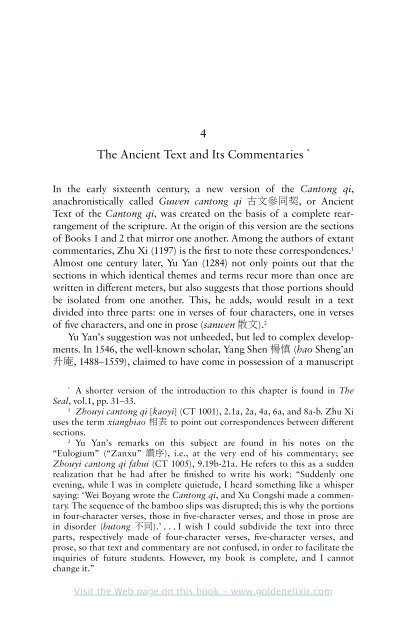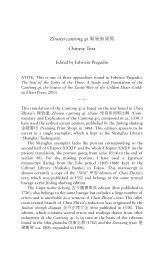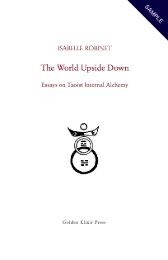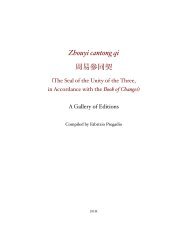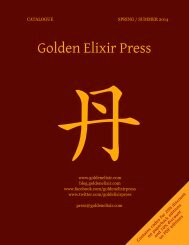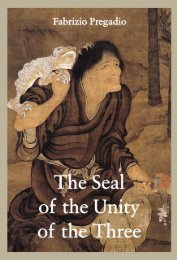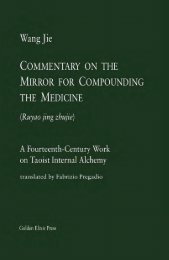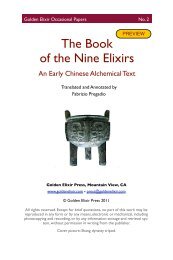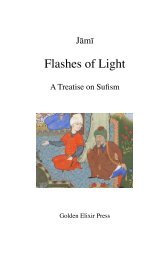The Seal of the Unity of the Three â Vol. 2 - The Golden Elixir
The Seal of the Unity of the Three â Vol. 2 - The Golden Elixir
The Seal of the Unity of the Three â Vol. 2 - The Golden Elixir
- No tags were found...
Create successful ePaper yourself
Turn your PDF publications into a flip-book with our unique Google optimized e-Paper software.
4<br />
<strong>The</strong> Ancient Text and Its Commentaries *<br />
In <strong>the</strong> early sixteenth century, a new version <strong>of</strong> <strong>the</strong> Cantong qi,<br />
anachronistically called Guwen cantong qi 古 文 參 同 契 , or Ancient<br />
Text <strong>of</strong> <strong>the</strong> Cantong qi, was created on <strong>the</strong> basis <strong>of</strong> a complete rearrangement<br />
<strong>of</strong> <strong>the</strong> scripture. At <strong>the</strong> origin <strong>of</strong> this version are <strong>the</strong> sections<br />
<strong>of</strong> Books 1 and 2 that mirror one ano<strong>the</strong>r. Among <strong>the</strong> authors <strong>of</strong> extant<br />
commentaries, Zhu Xi (1197) is <strong>the</strong> first to note <strong>the</strong>se correspondences. 1<br />
Almost one century later, Yu Yan (1284) not only points out that <strong>the</strong><br />
sections in which identical <strong>the</strong>mes and terms recur more than once are<br />
written in different meters, but also suggests that those portions should<br />
be isolated from one ano<strong>the</strong>r. This, he adds, would result in a text<br />
divided into three parts: one in verses <strong>of</strong> four characters, one in verses<br />
<strong>of</strong> five characters, and one in prose (sanwen 散 文 ). 2<br />
Yu Yan’s suggestion was not unheeded, but led to complex developments.<br />
In 1546, <strong>the</strong> well-known scholar, Yang Shen 楊 慎 (hao Sheng’an<br />
升 庵 , 1488–1559), claimed to have come in possession <strong>of</strong> a manuscript<br />
*<br />
A shorter version <strong>of</strong> <strong>the</strong> introduction to this chapter is found in <strong>The</strong><br />
<strong>Seal</strong>, vol.1, pp. 31–33.<br />
1<br />
Zhouyi cantong qi [kaoyi] (CT 1001), 2.1a, 2a, 4a, 6a, and 8a-b. Zhu Xi<br />
uses <strong>the</strong> term xiangbiao 相 表 to point out correspondences between different<br />
sections.<br />
2<br />
Yu Yan’s remarks on this subject are found in his notes on <strong>the</strong><br />
“Eulogium” (“Zanxu” 讚 序 ), i.e., at <strong>the</strong> very end <strong>of</strong> his commentary; see<br />
Zhouyi cantong qi fahui (CT 1005), 9.19b-21a. He refers to this as a sudden<br />
realization that he had after he finished to write his work: “Suddenly one<br />
evening, while I was in complete quietude, I heard something like a whisper<br />
saying: ‘Wei Boyang wrote <strong>the</strong> Cantong qi, and Xu Congshi made a commentary.<br />
<strong>The</strong> sequence <strong>of</strong> <strong>the</strong> bamboo slips was disrupted; this is why <strong>the</strong> portions<br />
in four-character verses, those in five-character verses, and those in prose are<br />
in disorder (butong 不 同 ).’ . . . I wish I could subdivide <strong>the</strong> text into three<br />
parts, respectively made <strong>of</strong> four-character verses, five-character verses, and<br />
prose, so that text and commentary are not confused, in order to facilitate <strong>the</strong><br />
inquiries <strong>of</strong> future students. However, my book is complete, and I cannot<br />
change it.”<br />
Visit <strong>the</strong> Web page on this book • www.goldenelixir.com


